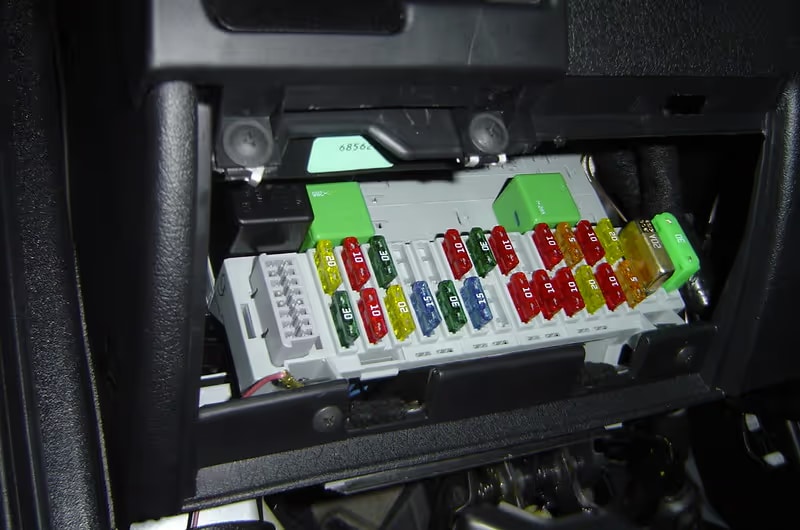

Car’s Fuse Box by Henrique Pinto is licensed with CC BY 2.0 Deed
A car’s fuse box is the central hub for distributing power and protecting the vehicle’s electrical components. Understanding how to read and navigate this critical system is a valuable skill for any Baton Rouge, Louisiana, driver. Our Gerry Lane Chevrolet dealership has created this straightforward guide to help car owners identify and resolve common electrical issues to enhance their vehicle maintenance skills and confidence.
Understanding a Car’s Fuse Box
The primary role of a fuse box is to prevent electrical overloads and protect a car’s circuits from damage. It consists of a series of fuses, relays, and diodes that work together to ensure the proper functioning of the vehicle’s electrical system. The main fuse box is typically located under the hood, while secondary fuse panels might be inside the car, often near the dashboard or steering wheel.
The fuse’s wire conductor breaks when the current exceeds the ampere limit, which manufacturers usually define along with different color codes on each fuse. Relays are electrically operated switches that control various car circuits, such as heaters and headlights. At the same time, diodes allow the flow of DC in one direction and prevent voltage spikes or flyback that may occur in winding coils found in relays.
Step-by-Step Guide to Reading a Fuse Box
Locating the Fuse Box
To begin with, drivers should consult their vehicle’s owner’s manual to find the exact location of the main fuse box and any secondary fuse panels. In most cases, the main fuse box is situated under the hood, near the battery, while secondary panels can be found in the passenger compartment, often hidden behind a removable panel.
Interpreting the Fuse Box Diagram
Once they’ve located the fuse box, they must open the cover and look for a diagram on the inside. This diagram indicates the location and purpose of each fuse within the box. Drivers should take a moment to familiarize themselves with the layout and the various components protected by each fuse. They can refer to the owner’s manual for a more detailed schematic if the diagram is missing or unclear.
Identifying Fuse Types and Conditions
Fuses come in different types, such as blade fuses (the most common in modern vehicles), glass tube fuses, and cartridge fuses. Blade fuses are color-coded according to their amperage rating, which appears on the fuse itself. To check for a blown fuse, car owners can look for a broken wire inside the transparent housing or use a multimeter to test for continuity.
Replacing a Blown Fuse
If a fuse has blown, replacing it with one of the same amperage rating is crucial. Using a fuse with a lower amperage can cause it to blow prematurely, while a higher amperage fuse may allow the connected component to become damaged before the fuse blows. To replace the fuse, drivers must carefully remove it using fuse pliers or their fingers and insert the new fuse securely into the same slot.
Gerry Lane Chevrolet’s Tips for Fuse Box Maintenance
Certain precautions are essential to ensure a vehicle’s electrical system works properly. Drivers should regularly inspect fuse boxes for signs of corrosion or damage and clean them as needed.
If the driver experiences recurring electrical issues or blown fuses, they must seek the help of a professional vehicle technician, who can diagnose and resolve the underlying problems causing these issues.
In addition to regularly checking and cleaning the fuse box, it’s a good idea to keep a well-stocked emergency kit in a vehicle. This kit should include a selection of spare fuses in various amperage ratings and a pair of fuse pliers or tweezers for easy removal and installation. By taking these precautions, drivers can minimize the risk of being stranded due to a blown fuse.
Fuse boxes in cars usually have empty fuse sockets for future features, which car owners can use to store spare fuses. When pulling out spare fuses, they must be cautious and use the fuse box diagram to ensure they have the correct amperage rating.
Common Questions and Answers
Q: Are fuse boxes the same in all vehicles?
A: While the type of fuse remains consistent across all vehicles, the layout and configuration of fuse boxes can differ depending on the specific make and model of the car.
Q: How many fuse boxes are in a vehicle?
A: Usually, there are two fuse boxes in a car, one located under the hood and the other near the dashboard or steering wheel.
Q: Are car fuses expensive to replace?
A: Car fuses are not expensive and are often available in packs with variable ampere range, costing between $10 to $50 depending on the type and quantity.
By understanding a vehicle’s fuse box and following these maintenance tips, drivers can better handle minor electrical issues and keep their cars running smoothly. However, some electrical problems may be too complex for the average driver to diagnose and repair. In these cases, they must seek assistance from a skilled professional.
Importance of Professional Help for Complex Electrical Issues
The expert technicians at our Gerry Lane Chevrolet dealership in Baton Rouge have the knowledge, tools, and experience to identify and resolve even the most challenging electrical issues, ensuring every customer’s vehicle remains safe and reliable.
If you suspect your car has electrical issues or notice recurring blown fuses, please don’t hesitate to bring it to us for a thorough inspection. Our team of certified technicians provides top-notch service and support to keep your vehicle running smoothly. Take advantage of our service and parts specials and schedule your appointment today.